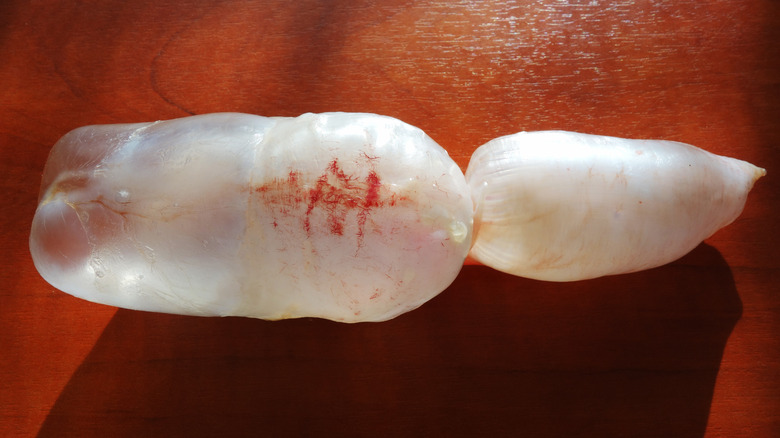Fish Bladder Jam's History Is Just As Unusual As Its Name
If you were to walk into Walmart or any local grocer, chances are that if you had a grocery list that called for "fish bladder jam," you're pretty much out of luck. Fish bladder jam may sound like some made-up ingredient used by witches in a children's storybook, but this odd-sounding ingredient actually has a long, weird, and colorful history behind it.
Before we talk about the specifics of fish bladder jam, we must first talk about isinglass. Isinglass, according to Sky History, is a type of binding agent harvested from the dried swim bladders of fish, such as sturgeon. If you're not exactly a marine biologist like George Costanza, the swim bladder of the fish is an organ that helps fish stay above or below certain levels of water, with Bass Angler Magazine comparing the bladder to our lungs. Think of the bladder as a weight, helping the fish to stay in deeper waters or rise closer to the surface without the fish needing to expend energy to move. But since the fish used for fish bladder jam most likely will not be needing that bladder anymore, the bladder is dried and the gooey, gelatin-like substance is harvested from it, thus making isinglass. Fun!
But who exactly thought of fish bladder jam to begin with? What was it used for?
Fish bladder jam can be traced back to the Victorian Era
As Sky History explains, the first people to discover the "wonders" of fish bladder jam were the people of the Victorian Era. They discovered that the properties of isinglass were perfect for use as a binding agent in certain dishes, although the jam's primary use was to be used in glue. Since gelatin, as we know it today, was still a ways off, all-natural "fish glue" (aka fish bladder jam) was a suitable substitute for basic dishes and even confectionary treats. Over time, gelatin became cheaper and much more effective than bladder jam, and so the custom fell out of practice.
But before you go thinking that we've grown beyond using fish jam in our food and drink, unlike our wacky Victorian ancestors, you may have had some fish bladder jam without even knowing it. As JSTOR Daily reports, isinglass is actually used by some distilleries to ferment beer and wine, removing yeast particles during the fermentation process. American Craft Beer explains that it works as a "filter" of sorts, removing protein haze and other such particles out of the beer to keep it clear and pure. Fortunately, it's not famous for its fishy taste.
While fish bladder jam may sound off-putting at first, it's certainly not the first weird food people have been eating for the longest time.

